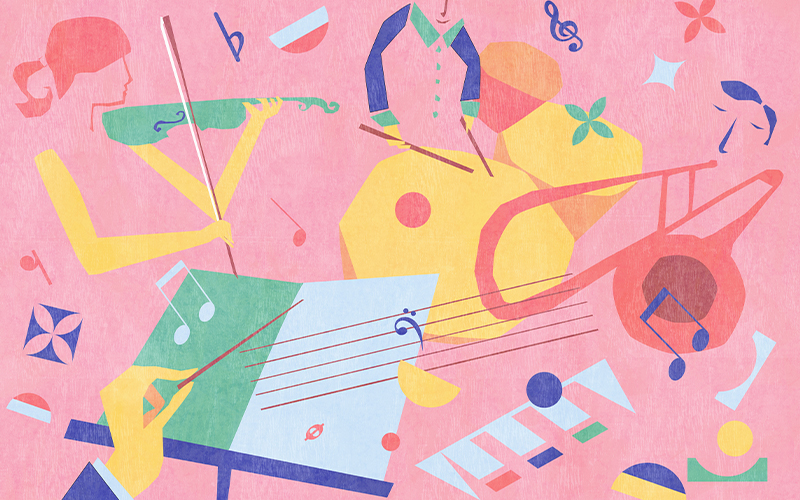Music is very much like a painting. When painting a picture, you think about the composition, colours, textures, and brush techniques. The same goes for a piece of music. Sound can have a variety of colors and tones, both warm and cool.
You may think, “how do you see colour in music?” Well, first, let’s narrow it down to just warm and cool tones. Like painted artwork, organising sound can effectively create a sense of warmth or an icy and cool atmosphere. Colours can be associated with specific emotions; yellow for happiness, blue for coldness, and green for envy. Composers can achieve those emotions using certain compositional techniques through instrumentation, texture and timbre. In turn, this resolves in having warm and cool tones. Here we will discuss how to identify these tones and some examples of film music using them.
What are Warm Tones?
Warm tones are associated with colours such as red, orange and yellow. When we think of visual elements, we may think of sunrises, sunsets and golden hour. In music, warm tones are denoted to sounds that lean towards bass frequencies. The tracks tend to be bass-heavy, applying that warm foundation for the rest of the tones to build upon. Being more favoured towards the bass frequencies allows the sound to become softened. The presence of higher frequencies is very little to non-existent.

Achieving warm tones in music is done in a variety of ways. An instrumental example would be soothing string chords that sit between the low and mid-range of the pitch. With the long sustained notes that have subtle vibrato, it creates a very cosy sensation. This idea goes the same for ambient music. The lack of higher synth sound frequencies results in a much warmer tone.
What are Cool Tones?
Cool tones are much brighter and harsher at the opposite end of the sound spectrum. Cool tone colours include blues, purples and greens. These aren’t as popular as warm tones. However, they can create a sense of coolness in the air. The higher frequencies are favoured much more, with an absence of mid to low frequencies. The harsher and brighter these sounds are, the better for those high-intensity or shimmering moments.
While you can have very smooth and sustained mid to low tones, going higher in pitch and volume can create a colder sound. When we look at string instrumentation, the point of contact where the bow meets the string can drastically change the tone. The closer it is to the fingerboard, the more delicate and warm the sound is. The closer the bow is to the bridge, the harsher the sound is.
This allows more tone in the harmonic series from the fundamental note to be heard and has a pretty cool effect! This specific technique is called sul ponticello and is associated with glacier-like sounds. The listening experience isn’t as pleasant, but both coolness and harshness complement each other considerably in terms of sound. Here’s a video demonstrating sul ponticello on the cello!
Musical examples of Warm Tones
Warm tones in music are used pretty much everywhere. Most cinematic music is compiled of warmer tones rather than cool tones. The deeper bass creates an other-worldly sound that helps the audience transport themselves into the on-screen universe.
The film score for Oblivion, composed by M83, has many warm tones. The score is compiled mainly of strings and heavy bass, but these two families of instruments produce beautiful and in-depth tones. Jack’s Dream, which opens the tracklist, is warm and grand. While it may open with high-pitched sustained strings, its role in the grand scheme of things is another layer upon much thicker textures heard later. The most poignant instrument used here is the french horn. This brass instrument is known for its pleasant tone and certainly falls under warm colours. The tremolo strings fall in the mid-range of the pitch, so it doesn’t sound harsh. The piano then takes over the horn melody.
An interesting factor is that warm music tends to be mixed, favouring the mid to low frequencies. The solo piano, for example, sounds slightly muffled. This is likely down to the equalisation in which the higher piano frequencies have been cut off, producing a softened timbre. Reducing the brightness can change the overall tone.
Musical Examples of Cool Tones
Cool tones are sometimes fused with warm tones. However, there are instances where these sounds can become the dominant element of the track. At this end of the spectrum, other than conveying colder and ice-like sounds, these can also be great for enticing fear and suspense.
Composer Hildur Guðnadóttir has a unique sound that I find pretty chilling. An example of this can be found in her score for Chernobyl, specifically in the Bridge of Death. A standout element in this score is the metallic sounds heard throughout. This track has high-frequency piercing drones that penetrate the warmer pulsating drone underneath. The slow-moving melody is super haunting due to its industrial-like sound. There are little to no lower frequencies in that melody, focusing the timbre on the higher end. I have written about her captivating sound world; if you’d like to explore more of her music, you can do so here.
Cool tones don’t necessarily have to mean suspense and tension. They can also show their glimmering side. Max Richter‘s The Leftovers (Season 2) is a fantastic score with various gripping sound worlds. The track Entropy for Meg shimmers and glows with the presence of high-pitched bowed strings.
Notice how it also sounds likes screams? It’s a wash of beautiful sound that still has that uncertain undertone from the screech-like violins. Comparing this track to Jack’s Dream, the warm tones aren’t there. It feels colder but has a sense of hope. This is suddenly interrupted by some heavily reverberated bass drums. The intensifying sound effect heard at the end can also be considered cool-toned. The scratchiness of the sound effect is very polarised within the higher frequencies.
How to use Warm and Cool Toned Music
We now know how to find warm and cool-toned music, but how do we use it? Music is subjective, just like any other art form. It’s all down to the individual in the creative process. Building up a playlist of some warm and cool tracks and then playing them against what you have on screen is a great starting point.
When choosing a track, if you have a landscape scene that has a warm colour palette, some soft strings or ambient music will elevate those colours. This music can still have higher frequencies. These are only added as a dash of texture. The dominant sound will be those warm tones. Warm tones will be your friend when looking to dialogue moments with great significance within romance or comfort.
Cool tones are perfect if you have a shot of some glaciers and a mysterious and uncertain nature in the air. The lack of low frequencies takes away that audible comfort, effective for that feeling of mystery on the horizon or some tension. You may have a tense scene in an industrial environment, and looking out for those metallic cool-toned sound worlds gives you an edge. But higher-pitched strings and synths will do the trick for those who want sparkle and shimmer.
Cover image via Shutterstock/Ikon Images
For more on audio, check out these articles:
7 Best Horror Game Soundtracks To Inspire Your Next Film
What is ASMR and How Can You Make It?
The Best Audio-Based YouTubers You Should Be Watching

